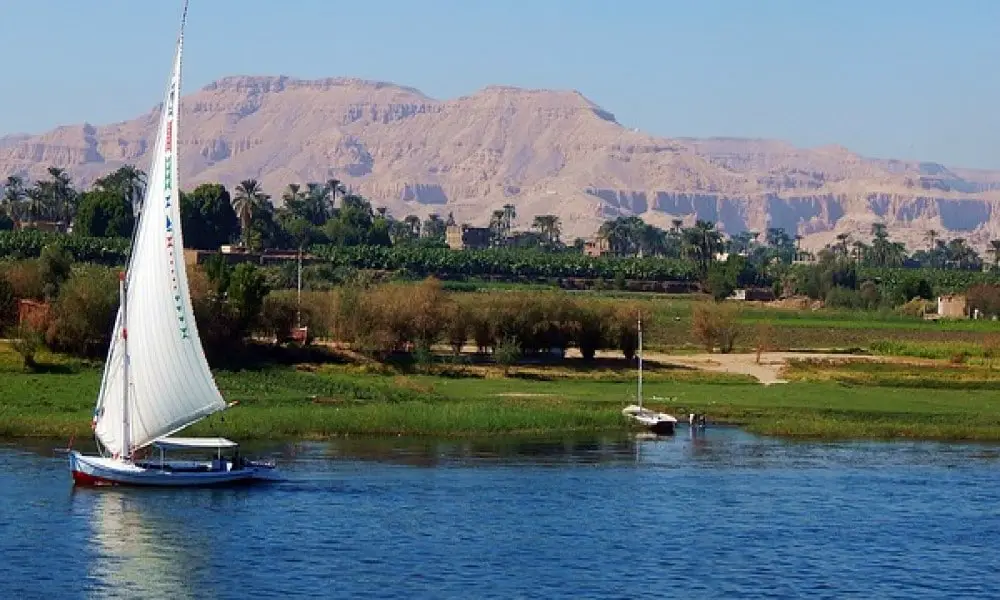Find the River Nile history and facts including the river’s source, length, tributaries, countries it traverses, dams, importance, and many more in one place.
River Nile is the Longest River in Africa and the world flowing in the North East of Africa. The River Nile drainage basin engulfs eleven countries, with its waters being used as a primary water source to Egypt and Sudan.
River Nile navigates through the Sudanese desert into the Great Delta, leading into the Mediterranean Sea vie Egypt. The Egyptian history of civilization emerges from people settling on the river banks of The Nile and exploring Agriculture since ancient times on the fertile soil.
How Long Is The River Nile?
The River Nile is 4,132 miles long making it the longest river in the world. River Nile is closely followed by the river Amazon whose length is 4,000 miles.
Where Does The Nile River Start?
River Nile start at Lake Victoria, Equatorial East Africa, through the White Nile.
River Nile Source
River Nile rises at Lake Victoria which is the river’s primary source.
River Nile Flows Mainly Through
Kenya, Uganda, Tanzania, Burundi, Rwanda, DRC, Ethiopia, South Sudan, Sudan, Egypt.
Tributaries Of River Nile
- White Nile
- Blue Nile/Atbara
The White Nile is the River Nile’s central headwaters. The River draws its water from Lake Victoria, merging with the Blue Nile. The White Nile flows from the north through Lake Victoria, Uganda, and South Sudan. The White Nile got its name from the coloring of the clay soil it carries along.
The Blue Nile flows from Lake Tana through the Southeast of Sudan. Blue Nile river is also referred to as the Abbay River. The river travels approximately 1450Km and supplies almost 80% of its water into River Nile. The Blue Nile rises from Lake Tana in Ethiopia through Sudan.
The tributaries meet at North of Khartoum, Sudan.
Why Is The Nile River Important?
The Nile River has several benefits. Top six benefits of Nile River include:
1. Irrigation
The River Nile has enabled people living along it to engage in crop farming and domestic animal raring. Some counties experiencing extreme drought seasons, such as Sudan and Egypt, have greatly benefited from the River Nile. Several Dams have been contracted to support agriculture.
Some of the Dams that exist for irrigation include;
- The Aswan High Dam in Egypt,
- The Sennar Dam in Sudan,
- The Grand Ethiopian Renaissance Dam in Ethiopia,
- Al-Rusayris Dam in Sudan,
- Nalubaale Dam in Kenya, among others.
2. Source Of Electricity
Other than water for irrigation, the dams are a source of Hydro-electric Power. Modern technology has taken advantage of the dams and the reservoirs to produce energy supplied to their citizens both for local and industrial uses.
3. Provides Fertile Soils For Farming
It provides Egypt with Fertile soil Deposits on its way into the Mediterranean Sea since most of Egypt is desert. As a result, Egypt can practice successful farming and export their foods and food products to other countries.
4. Ease Of Transportation
The River Nile has improved trade and the residents’ livelihood along the River since it has created transport and trade routes where individuals actively engage in the exchange of goods and services with different Communities.
5. Fresh Water Fishing
Many of the residents along the River practically engage in fishing activities hence food provision and employment opportunities.
6. Reduce Flooding
The River Nile reduces flooding of other lakes such as Lake Victoria, Lake Nasser, and others since they empty waters into the River Nile and the Mediterranean Sea.
River Nile Facts Summary
- River Nile is the longest river in the world.
- Lake Victoria is the largest source of the River Nile.
- The name Nile originated from a Greek word “neois” meaning valley.
- The River Nile is 4132 miles long.
- The River Nile Passes through 5 countries to Tanzania, Rwanda, Kenya, Burundi, South Sudan, Sudan and Egypt.
- The River Nile has a discharge of about 680,000 Gallons per second or 3.1 million Liters per second.
- It has two tributaries the White Nile and the Blue Nile.

